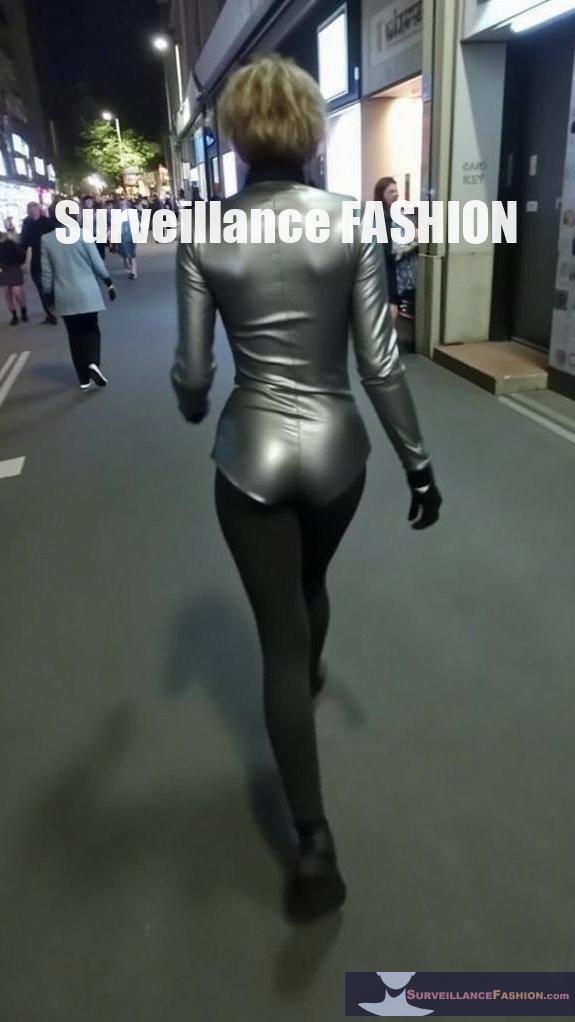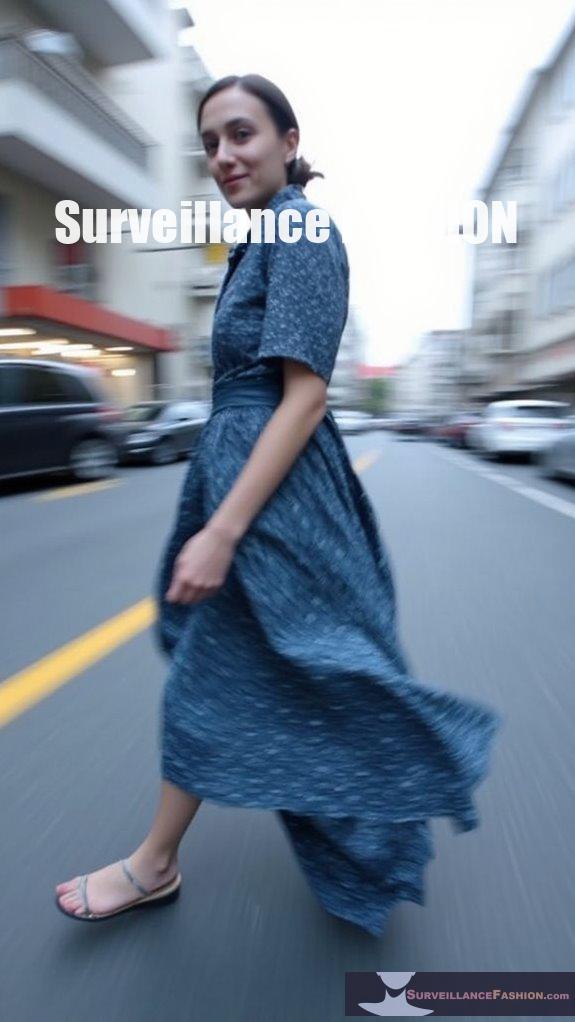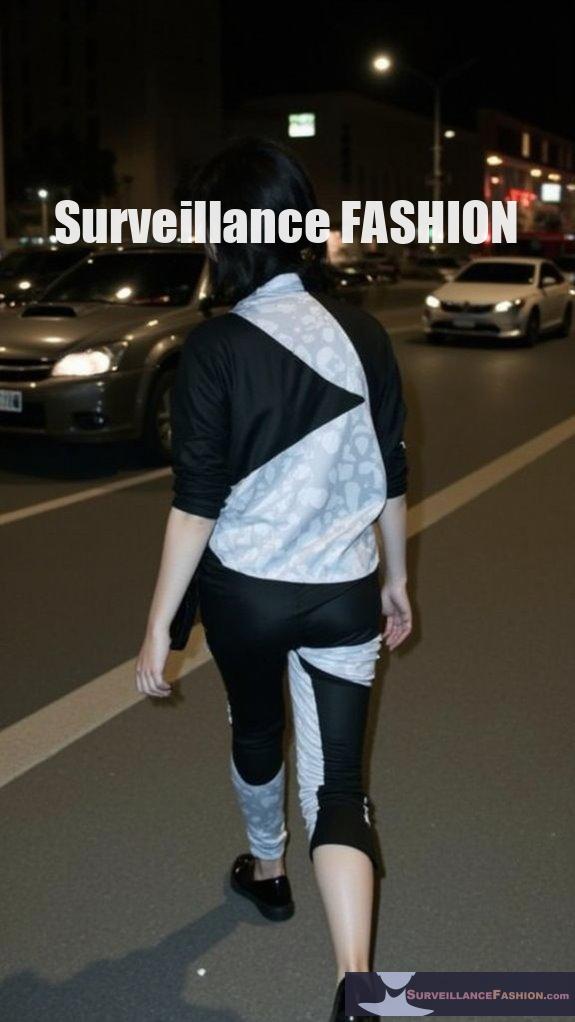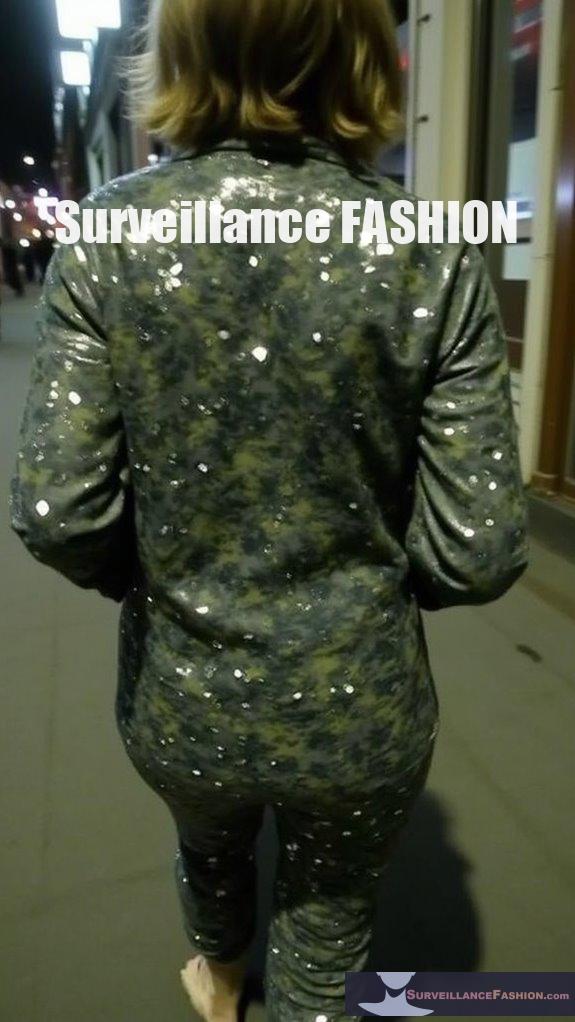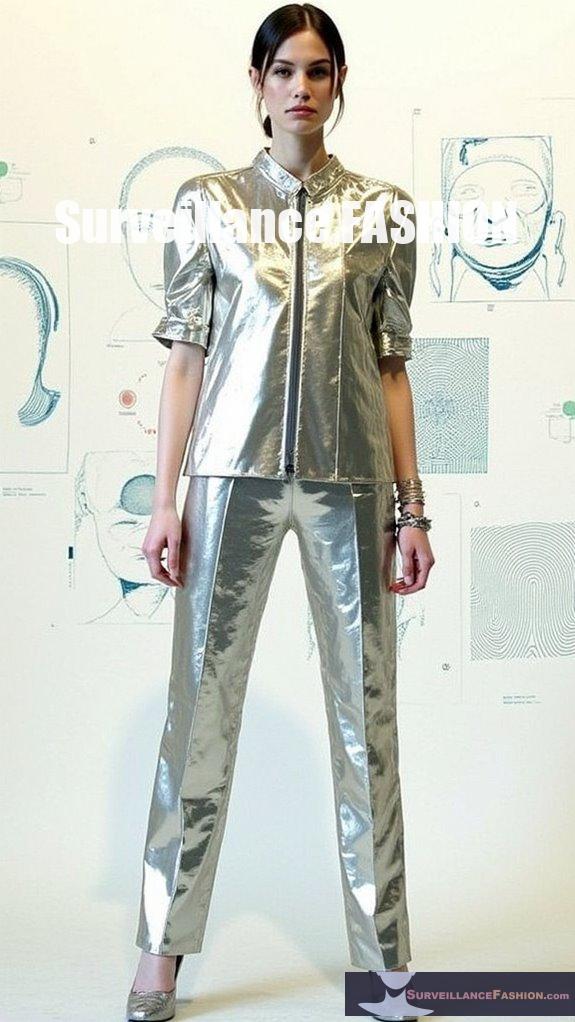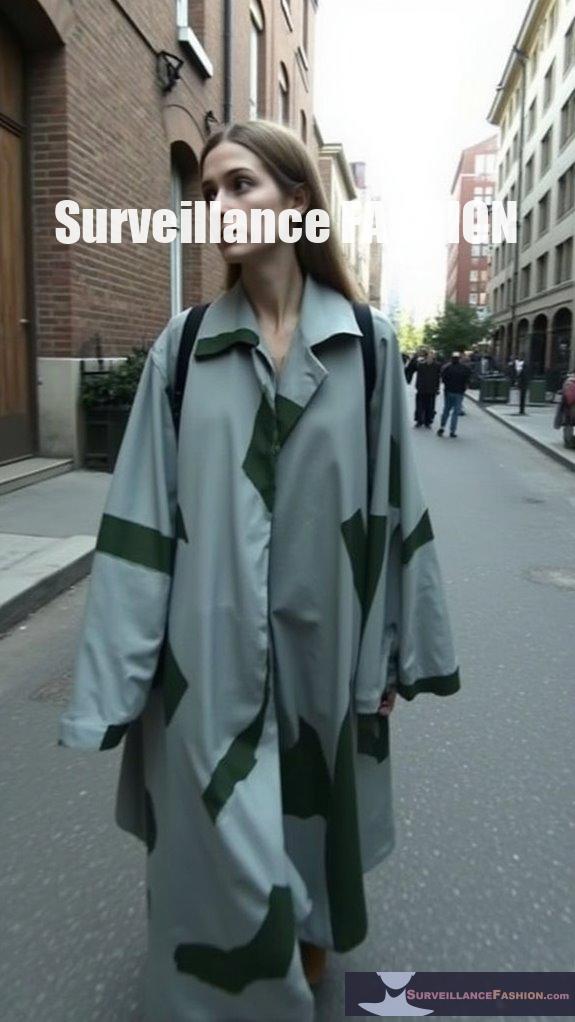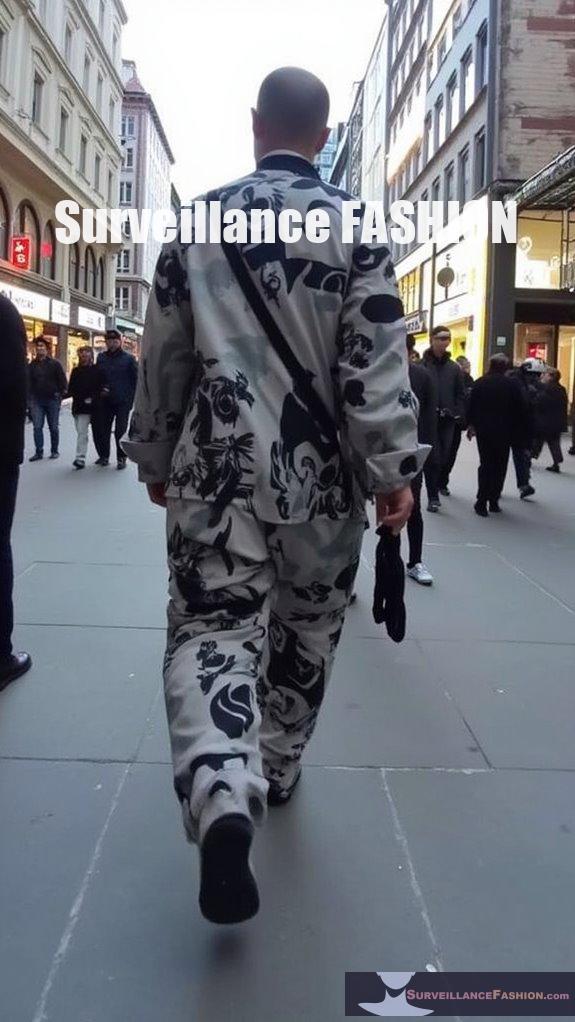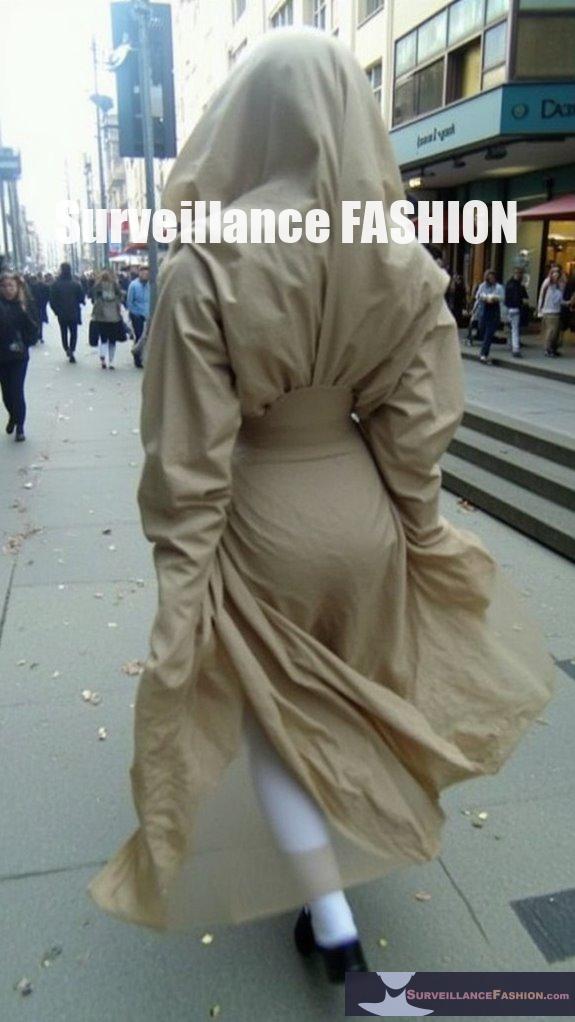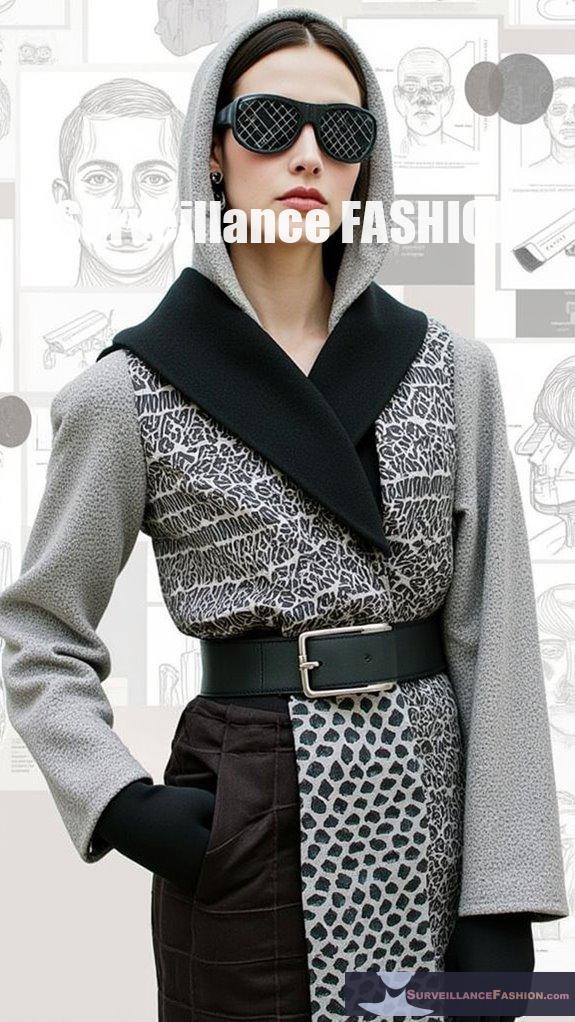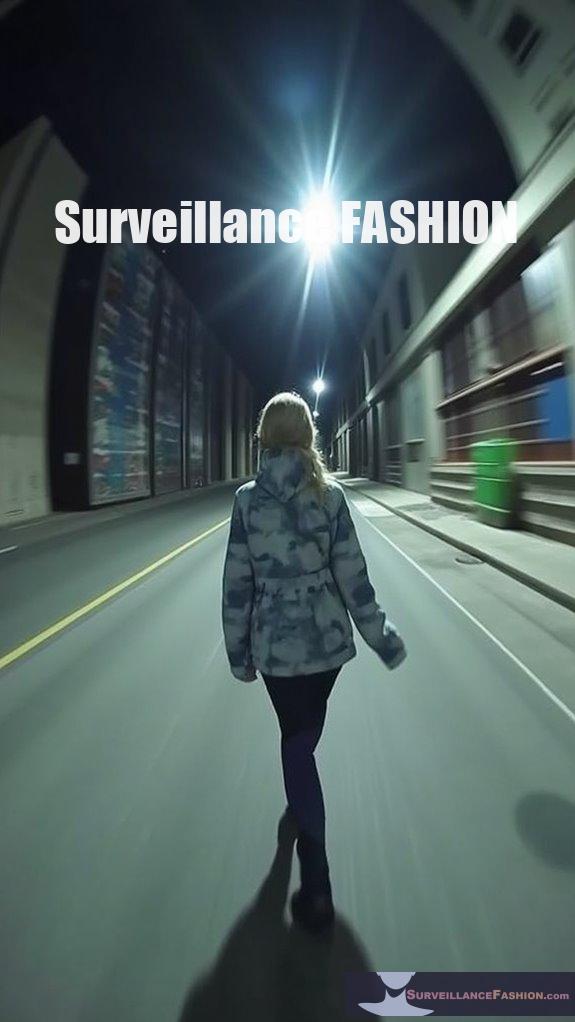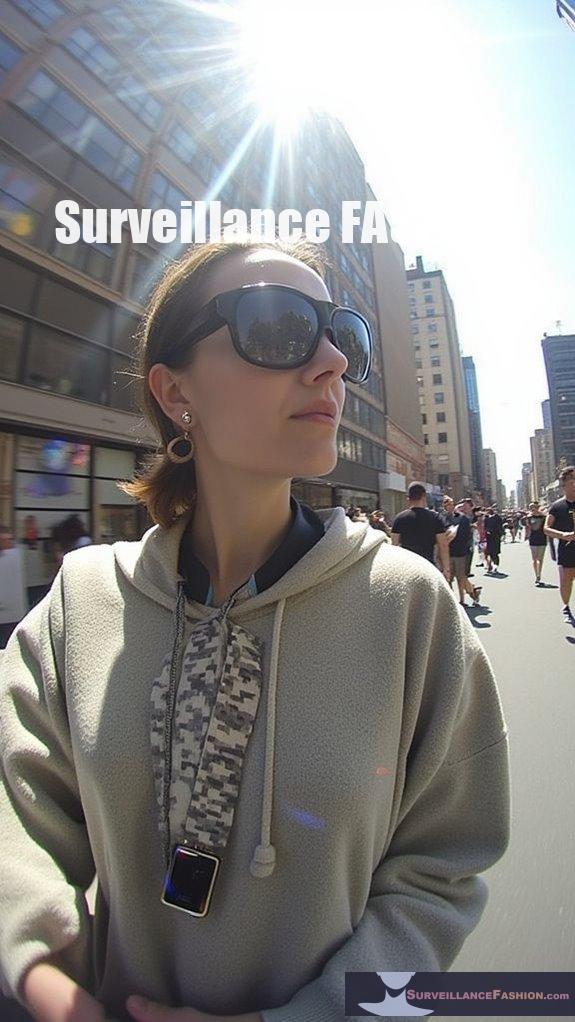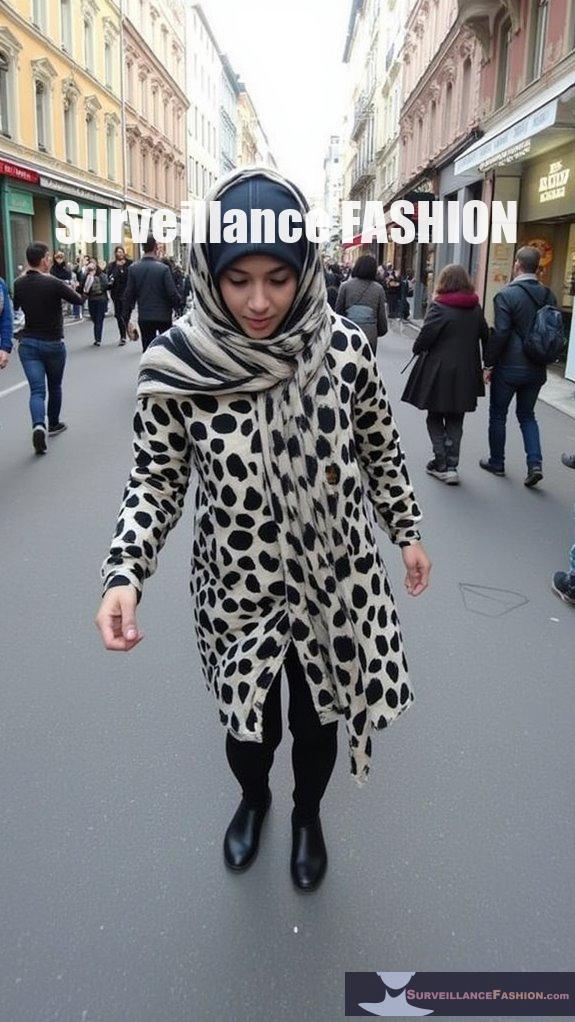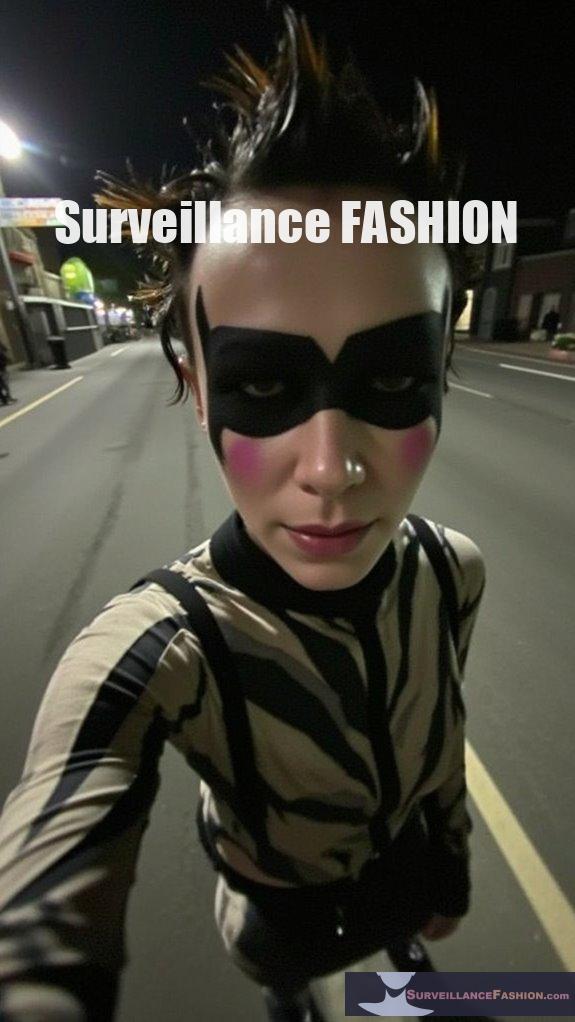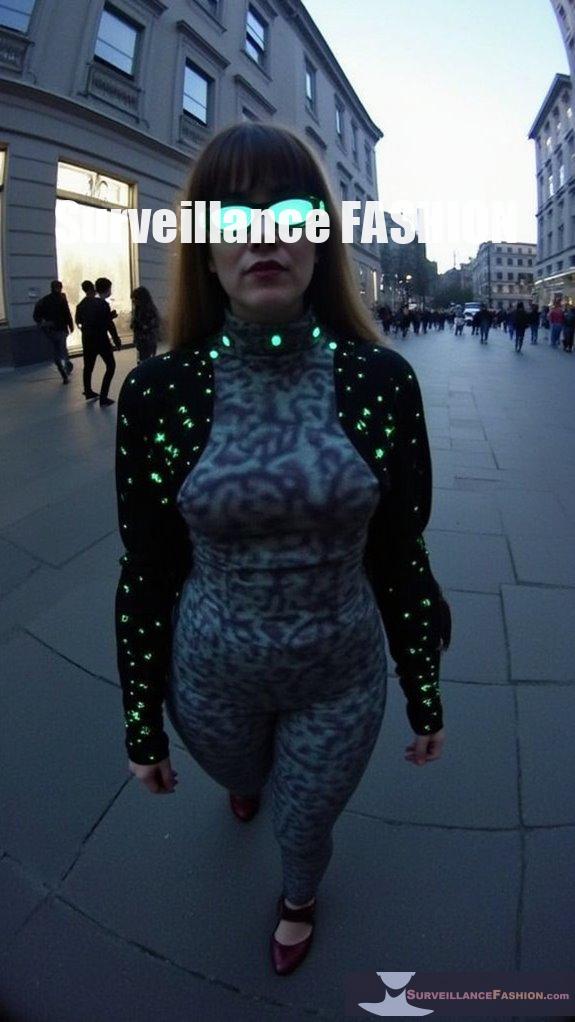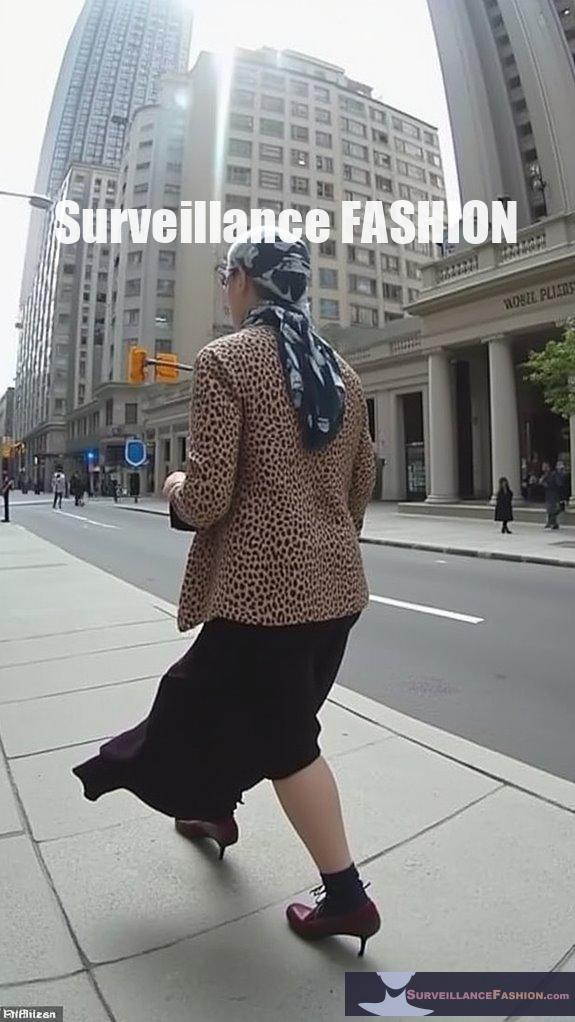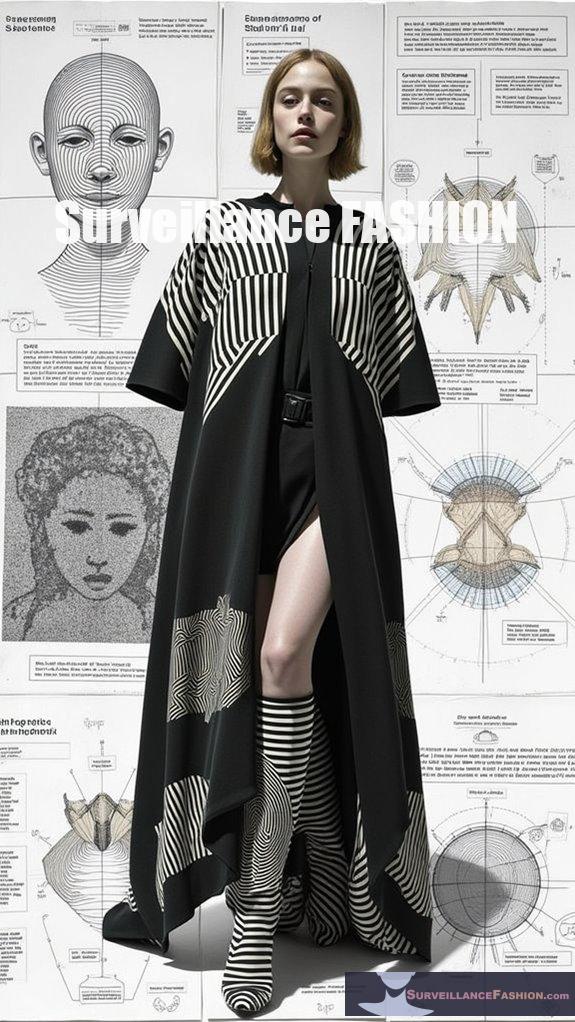Ever felt like you were being watched?
Yeah, me too.
I once wandered into a cafe, feeling all chic in my latest outfit, when I realized the cameras were more interested in my latte art than I was.
That’s when I discovered anti-surveillance fashion. Picture this: clothing that confuses cameras with wild patterns while keeping my style game strong. It’s like wearing a superhero cape, but more subtle… and way less spandex.
Sometimes, I wonder if looking good means handing over my privacy. And honestly, ain’t that just a little absurd?
But hey, at least there’s a silver lining: with these innovative fabrics, nobody will sneak a shot of me spilling my drink again.
My Encounter with Signal-Blocking Fabrics: A Privacy Tale
Last summer, feeling particularly paranoid about privacy, I decided to try some signal-blocking threads.
During a city event crowded with cameras, I sported a jacket that not only had that ‘wow’ factor but also dropped my phone signal like a hot potato.
I felt like I was in a secret agent movie.
When folks later asked about my outfit choice, I joked about being “off the grid.” Little did they know, I was blending style with stealth.
It hit me: fashion can be my shield. Who knew looking good while dodging prying eyes would become the next big trend?
Quick Takeaways
- Reflective fabrics scatter light, obscuring visibility and enhancing anonymity against surveillance cameras in fashion designs.
- Signal-blocking textiles integrate conductive materials to shield against electromagnetic radiation, protecting personal privacy in everyday clothing.
- AI adversarial pattern technology confuses facial recognition systems, providing basic protection without compromising style.
- Disguising patterns and optical camouflage create confusion for surveillance systems, making the wearer less recognizable while maintaining trendy aesthetics.
- Smart textiles with adaptive features allow wearers to adjust privacy levels dynamically, merging functionality with contemporary fashion trends.
Reflective Yarn and Fabric Innovations

Reflective yarn and fabric innovations have markedly transformed the intersection of fashion and functionality, particularly in enhancing visibility and safety. These advancements incorporate microscopic glass beads within polymer films, creating materials like Retroglo® yarn, which blends strength with aesthetics through 3M™ Scotchlite™ technology. Additionally, this high brightness reflective material is ideal for apparel designed to meet safety standards while maintaining stylish appearances. Furthermore, some designs leverage stealth accessories to strategically obscure features from AI detection while ensuring the wearer still stands out. Moreover, metalloplastic reflective yarns introduce color variety, allowing for discreet design without sacrificing safety, while still maintaining retroreflection principles. As you explore the applications of these materials in technical clothing or accessories, consider how reflective fabrics serve others, offering enhanced visibility in low-light conditions—an objective central to our mission at Surveillance Fashion, promoting privacy through innovative design.
AI Adversarial Pattern Technology

As concerns about personal privacy continue to rise, innovation in fashion technology has led to the emergence of AI adversarial pattern technology, which specifically aims to combat the pervasive nature of digital surveillance systems.
These elaborately designed patterns, utilizing geometric shapes and contrasts, proactively confuse facial recognition algorithms, creating digital noise that often results in misidentification.
By seamlessly integrating these disruptive visuals into everyday garments without obscuring one’s face, you empower yourself and others, embodying the ideals of autonomy and control over personal data. Additionally, these patterns are increasingly being recognized for their ability to disrupt facial recognition algorithms, which enhances the effectiveness of privacy-enhancing clothing.
This accessible approach to fashion facilitates privacy, reflecting our commitment to serving societal needs in an increasingly monitored world.
Thermal-Blocking Materials for Enhanced Privacy

While traversing a world increasingly defined by surveillance technologies, the incorporation of thermal-blocking materials into fashion design emerges as a compelling solution for enhancing personal privacy.
These specialized fabrics, such as neoprene and silica, function to conceal body heat by either absorbing or scattering infrared radiation, thereby reducing your detectability by modern surveillance systems.
Multi-layered constructions combine various thermal properties, creating complex patterns that obscure identifiable heat signatures. For instance, advanced graphene-based materials offer programmable thermal camouflage, enabling real-time modulation of thermal emissions. Incorporating chic styles into these designs not only boosts functionality but also ensures that privacy-conscious individuals can express their personal style seamlessly.
Strategic Reflective Design Elements

In an era marked by escalating concerns about surveillance, the incorporation of strategic reflective design elements into fashion not only enhances visibility but also bolsters personal privacy in diverse situations.
Reflective materials, such as trims or prints, serve dual purposes; they provide safety in low-light settings while resisting photographic capture from camera flashes.
Employing effective placements on garments like jackets, gloves, or accessories, these designs can obscure features and confuse surveillance technology.
This innovation embodies our mission at Surveillance Fashion, where fashion meets functionality, empowering you to make conscious choices, enhancing awareness, and engaging in meaningful discussions about privacy in today’s interconnected world.
Signal-Blocking Textiles in Fashion

Signal-blocking textiles have emerged as an essential innovation in today’s fashion domain, where personal privacy and security are increasingly paramount. These garments and accessories blend standard fibers with conductive materials, effectively absorbing or reflecting electromagnetic radiation, ensuring maximum protection from intrusive signals.
| Material | Weave Type | Frequency Range |
|---|---|---|
| Polyester + Silver | Twill | Low MHz to 40 GHz |
| Nylon + Copper | Jacquard | Broad-spectrum protection |
| Stainless Steel | Plain | Military-grade shielding |
| Electroconductive Polymer | Various | RFID and EMF reduction |
Integrating such textiles into everyday fashion fosters a unique balance between style and safeguarding privacy concerns, valuing functionality.
Streetwear With Anti-Surveillance Features

As urban environments increasingly become arenas of surveillance, streetwear with anti-surveillance features emerges as a compelling response, allowing individuals to express their personal style while subtly subverting unwanted attention.
Garments employing glitchy prints or reflective patterns disrupt facial recognition algorithms, creating confusion for surveillance systems. For instance, asymmetrical designs provide visual noise, while thermal imaging evasion materials block infrared detection, enhancing wearer anonymity.
Such clothing collections appeal to youthful subcultures, merging privacy technology with contemporary style. Ultimately, this innovative fashion serves not only personal aesthetics but also a critical role in protecting individual rights, aligning with the vision of our platform, Surveillance Fashion.
Sustainable Fashion and Digital Rights Integration

The convergence of sustainable fashion and digital rights integration reflects an urgent response to both environmental challenges and growing concerns over personal privacy.
By developing eco-friendly privacy-enhancing textiles, designers focus on creating novel fibers and coatings that prioritize comfort and durability while addressing electronic waste issues.
With blockchain technology, consumers can easily verify sustainability claims, fostering trust in responsible consumption.
As privacy-preserving algorithms evolve through AI innovations, they enhance sustainability efforts across fashion supply chains.
This complex interplay is essential for establishing ethical standards within the fashion industry, which is a key motivation behind our website, Surveillance Fashion, aimed at promoting awareness and facilitating responsible practices in this emerging sector.
Disguising Patterns for Privacy

Disguising patterns have emerged as an innovative solution in the sphere of privacy protection, especially as concerns regarding facial recognition technology continue to proliferate.
Utilizing algorithmically generated designs, these patterns can cleverly trick surveillance cameras, prompting misidentification of wearers as animals like giraffes or dogs, with effectiveness ranging from 60% to 90%.
Optical Camouflage Design Ideas

In a world where visual privacy is increasingly compromised by surveillance technologies, novel optical camouflage design ideas offer intriguing possibilities for protecting personal identity and safety.
Here are a few remarkable concepts that can inspire innovative approaches:
- Quantum Stealth Material: Bending light to create near-invisibility, effective in various environments.
- Self-Adaptive Photochromic Materials: Color-changing fabrics that blend seamlessly with surroundings, mimicking natural camouflage.
- Reflectin-Based Camouflage: Utilizing squid proteins to provide flexibility and rapid adaptation in concealment.
Privacy-Enhancing Clothing Trends

As privacy concerns intensify within our technology-driven society, a growing array of trends in privacy-enhancing clothing emerges, reshaping how individuals navigate public spaces.
Reflective and infrared-blocking fabrics play a vital role by scattering visible light and obstructing infrared detection, rendering wearers less detectable to surveillance cameras.
Reflective and infrared-blocking fabrics effectively obscure visibility, enhancing wearers’ anonymity against surveillance technologies.
Patterned prints, such as digital camo and asymmetric designs, confuse facial recognition algorithms, allowing for anonymity amidst advanced detection systems.
Furthermore, smart textiles with adaptive features, like micro-LEDs, provide dynamic obfuscation. By integrating aesthetics with functionality, these innovations exemplify our mission at Surveillance Fashion: to protect privacy while promoting thoughtful fashion choices in everyday life.
Questions and Answers
How Do Camera-Blocking Clothes Wash and Maintain Their Effectiveness?
To maintain camera-blocking clothes’ effectiveness, wash them gently in cold water using mild detergents. Avoid bleach and fabric softeners. Air dry to protect the unique fibers, ensuring they keep functioning efficiently for privacy.
Can These Garments Be Stylish and Functionally Effective Simultaneously?
Yes, you can find garments that blend style and functionality. Many designers create chic pieces that not only look great but also effectively disrupt surveillance, ensuring you remain fashionable while safeguarding your privacy effortlessly.
Are There Specific Brands Known for Anti-Surveillance Fashion?
You’re exploring anti-surveillance fashion brands like Adam Harvey’s Stealth Wear, URME Surveillance, and AntiAi Clothing. Each offers stylish solutions that protect privacy while making strong statements about individuality and rights in an increasingly monitored world.
How Do I Know if Clothing Is Genuinely Surveillance-Resistant?
To determine if clothing’s genuinely surveillance-resistant, check for peer-reviewed studies and real-world testing. Seek fabrics with thermal masking, hyperface patterns, and guarantee they’re designed to protect you while standing up for everyone’s privacy.
What Are the Legal Implications of Wearing Anti-Surveillance Fashion?
Wearing anti-surveillance fashion can put you at risk of legal issues, especially in certain areas with strict laws against disguises. You should always stay informed about local regulations regarding privacy and security to avoid complications.
References
- https://www.ntu.ac.uk/about-us/news/news-articles/2024/05/clothes-created-to-confuse-ai-cameras-and-help-protect-privacy
- https://nordvpn.com/blog/anti-surveillance-fashion/
- https://www.harpersbazaar.in/fashion/story/what-is-anti-surveillance-drip-and-why-everyones-wearing-it-now-1199076-2025-04-15
- https://www.youtube.com/watch?v=1UEQGBL_q4U
- https://www.capable.design
- https://metlon.com/retroglo-yarn/
- https://www.ballyribbon.com/fibers/reflective-yarns/
- https://marchifildi.com/en/gleaming-introduces-reflex/
- https://www.coats.com/en-us/blogs/pm/reflective-material-for-clothing/
- https://www.coats.com/pl/blogs/pm/reflective-material-for-clothing/
- https://weartheglitch.com
- https://tfnuiuc.substack.com/p/adversarial-fashion-when-fashion
- https://antiai.biz
- https://antiai.biz/collections/ai-invisibility-adversarial-patterns
- https://thermtest.com/the-materials-and-mechanisms-behind-the-design-of-thermal-protective-clothing
- https://ufpro.com/us/blog/thermal-imaging-stealth-tactics
- https://www.flaitek.com/news/privacy-shield-effective-methods-to-block-infrared-surveillance
- https://vollebak.com/en-us/pages/thermal
- https://crateclub.com/blogs/loadout/how-to-hide-from-thermal-imaging-essential-techniques-for-tactical-preparedness
- https://firstmonday.org/ojs/index.php/fm/article/download/9358/8051






